… and some bonus games, just for fun!
Looking for new and different ways for students to practice their math skills? Games are a great way to not only practice calculations, but also notice patterns, short cuts and strategies! Here are a few to try with dice.
Where do I find dice?
– Check any games you already have at home. You might find some you can borrow.
– Buy some. They are cheap! Often there’s a pack in the toy section of the dollar store.
– Roll virtual dice (enter “roll dice” into google, and the first result is a simulator. Click on the image
of the cube to add dice)
Over the Mountain
Materials needed:
• 2 dice (or 3 dice in a variation, see below)
• Paper
• Pen or pencil
Goal: Be the first to climb your mountain, in number order, and then descend the other side. Math: Number recognition, addition & subtraction
Ages: 4+
Directions:
Set up: Each player needs a pencil and a piece of paper with the drawing of a mountain, labeled with numbers.
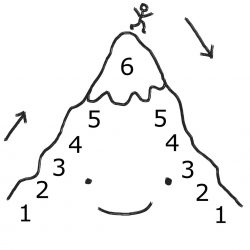
1. Youngest player goes first.
2. He rolls both dice once and hopes for a 1, which will allow him to cross off the number 1 at the start of
the mountain.
3. The numbers must be crossed off in order as you climb, so he cannot cross off the 2 until the 1 is
crossed off. However, if he rolls 1 and 2, both can be crossed off in the same turn.
4. Play continues until one player has made it all the way up the mountain and down the other side in the
correct order.
Variations:
Introduce adding
Allow the sum of the dice to also be counted. So, a roll of 1 and 2 would allow 1, 2, and 3 (1+2) to be crossed off! With this version, you can also increase the top number of the mountain (see “Climb a higher mountain” below)
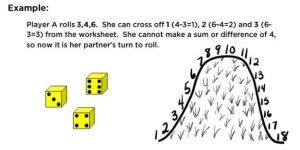
Include addition and subtraction
With this version, there are 4 possible moves with a single roll, the value of either roll, their sum, and their difference. So a roll of 6 and 1 would allow a player to cross off 1, 5, 6, or 7. This can be combined with “Climb a higher mountain” explained below.
Climb a higher mountain
When including addition and/or subtraction, try using 3 dice and change the top number to 9, 10, or 12, or try just ascending to 18.
Random Order
The nature of the game can be changed completely by allowing players to cross of their numbers in random order. However, the ascent must still be crossed off before a player can begin to descend the mountain. Play this variation with 3 dice and the numbers to 12. Each die may only be used once (but does not have to be used) in each turn. This introduces a strategic element into the game. Children will soon realize that it is better to cross off the higher numbers first.
Show Me the Money!
Materials needed:
• 2 dice
• Optional: coins (real coins or a play version)
Goal: Identify a combination of coins that add up to a given value
Math: Coins and their values, mental calculation, addition, subtraction (in the variation) Ages: 6+
Directions:
1. Roll two dice and make a two-digit number. (note: if the dice are two different colors, one color can always represent the number that will go in the tens place, and the other color can be the number that goes in the ones place). For example, a roll of 1 and 2 could become 12.
2. Say a combination of coins that would add up to the rolled value. Or, if coins are available, show a combination of coins that would add up to the amount rolled. For example, 12 cents can be a dime and 2 pennies.
 3. Each successful turn is one point. Play to a chosen number of points.
3. Each successful turn is one point. Play to a chosen number of points.
4. Another player can try to make the same total using less coins.
Variations:
Steal it
Another player can steal the point if he can make the same total value using fewer coins.
A Dollar to Spend
Each player is spending one dollar on his/her turn. The rolled value now represents the cost of a purchase (rolling a 5 and a 3 means the cost of the item was 53₵). How much change will they have left? Players must find coins that could be given as change from a dollar.
Beat that!
Materials needed:
• 1 die
• Paper
• Pen or pencil
Goal: Create the largest number
Math: Place value, strategic thinking, comparing numbers
Ages: 7+
Directions:
Set up your paper. For 5 rounds of making 3-digit numbers, the game paper would look like this:
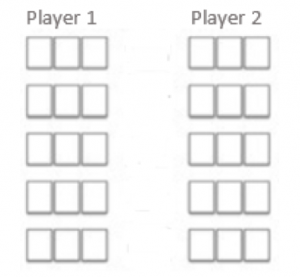
1. Player 1 rolls the die, and writes the number in one of his three boxes (ones, tens, or hundreds).
2. Player 2 then rolls the die, and writes the number in one of her three boxes.
3. Player 1 rolls again, placing their 2nd roll in one of the remaining two boxes. Player 2 does the same.
4. Each player rolls a third time. This number is written in the remaining empty box.
5. The largest 3-digit number wins the round and 1 point.
6. Repeat for a chosen number of rounds, winner has the most points.
Variations:
Reject
Add one reject box for each player. For every round, one of the rolls can be discarded by writing the number in the reject box. This adds another layer of strategy!
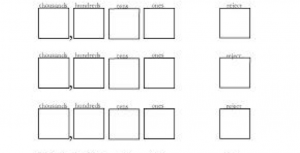
Change the place value
Try building a 4 or 5-digit number or add a decimal within the number. How does this change your strategy?
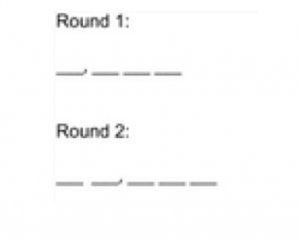
Change the goal
Instead of playing for the largest number, try playing for the smallest number.
Bonus
Use dice for more than math!
1. Roll a Story
Try one of these charts for story elements to help get your creative juices flowing. Take turns being the narrator and roll for a full story or pause and let someone else take over mid-story! This could also be done collaboratively with friends or family over the phone or exchanged through written messages.
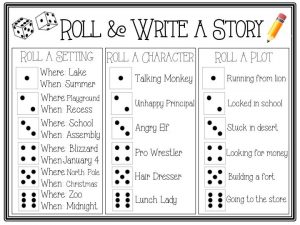
2. Dinner Conversation
Looking for something new to talk about? Have some fun with these questions by rolling the dice!
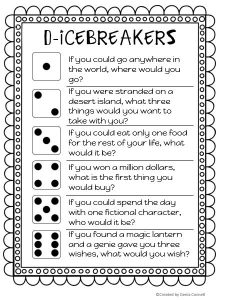
3. Roll a Question
Roll to get a question word, and then fill in the blank! Brainstorm a few, and then choose one that you want to find the answer to and do some research!
| 1. Who | 2. What | 3. Where | 4. When | 5. Why | 6. How |
4. Physical Challenges
How many dice can you keep spinning at one time?
How fast can you roll and stack the numbers in order?
Check out these and other challenges here: https://www.youtube.com/watch?v=hTgZfAp23zc